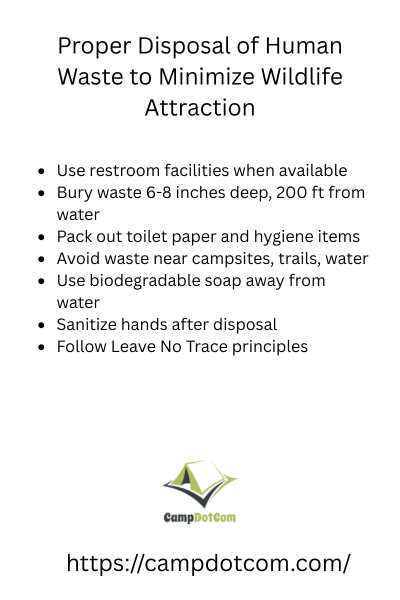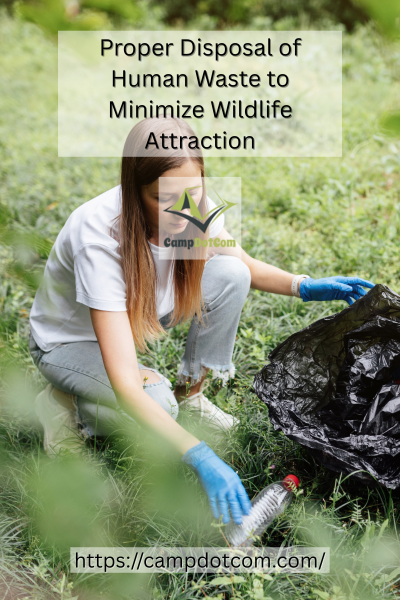Proper disposal of human waste to prevent attracting wildlife may not be the most exciting camping topic, but it is certainly one of the most important. It keeps the trail and campsite clean, protects wildlife and the environment, and to be honest, helps you keep your dignity as well.
I learned this lesson the hard way during a backpacking trip in the Smokies. My friend, who we will call “Bob” because I promised not to use his real name, thought that digging a hole “somewhere over there” was good enough. That night, a raccoon decided to pay us a visit. Apparently, Bob’s “somewhere” was far too close to camp. We ended up spending the rest of the evening guarding our food and tents like they were castle walls. Lesson learned: the forest has its own rules, and animals always follow their noses.
Read More About Proper Disposal of Human Waste to Minimize Wildlife Attraction

Why It Matters More Than You Think
If human waste is not managed properly, it is more than just unpleasant because it can easily draw the attention of wildlife. Bears, raccoons, and even curious squirrels have an impressive sense of smell. To them, waste might seem like food or at least something worth exploring. Once animals connect people with easy meals or unusual scents, they are likely to keep coming back.
As an Amazon Associate, I earn from qualifying purchases. Some of the links in this article are affiliate links. This means that, at zero cost to you, I will earn an affiliate commission if you click through the link and finalize a purchase.
This is not good for them or for us. A bear that learns to wander around campsites in search of food becomes a problem bear. A raccoon that sees a tent as a buffet becomes a problem raccoon and probably a problem for your sleep as well.
More Things to Know About Proper Disposal of Human Waste to Minimize Wildlife Attraction

Picking the Right Spot
So, what’s the game plan? First, distance is your friend. Always choose a spot at least 200 feet away from water, trails, and your campsite. That’s about 70 big steps if you don’t have a tape measure handy.
The reason for this distance is twofold: it keeps water sources safe from contamination, and it ensures your “business” stays private. Plus, it helps keep that smell far enough away that you won’t accidentally invite wildlife to your sleeping bag.
I like to think of it as setting up an invisible perimeter—a no-go zone for anything you’d rather not deal with later.
The Cat Hole Technique
For most situations, a “cat hole” is the best method for properly disposing of human waste and reducing the chances of attracting wildlife. All it takes is a small shovel or trowel and a willingness to do a bit of work.
Dig a hole about six to eight inches deep and wide enough to take care of business. When you are done, cover the waste completely with the soil you removed. Press it down gently with your foot or shovel so animals are less likely to dig it up.
Some people skip the shovel and use a stick or even their heel instead. I would not suggest that. A small camp trowel is light to carry and makes the job much easier and cleaner.
Toilet Paper: The Forgotten Culprit
Here’s something people often overlook: toilet paper is just as much of an animal magnet as the waste itself. Leaving it behind, even if it’s buried, can still draw curious noses.
The best option is to pack it out in a sealed bag. I know, it sounds gross, but think of it like carrying a used tissue in your pocket until you find a trash can. If you really can’t pack it out, make sure you bury it deep in the cat hole and use plain, unscented paper.
I once met a hiker who swore by using smooth river rocks instead of TP to avoid the issue altogether. I respect the creativity, but I’ll stick with paper, thanks.
When You Can’t Dig
Sometimes you’re in rocky ground, snow, or a desert where digging a hole isn’t possible. That’s where portable waste bags or “wag bags” come in. These special bags contain a gel that breaks down waste and seals in odors. They’re a bit pricier than just digging a hole, but they’re also required in some areas.
Think of it like having a personal, disposable bathroom that fits in your pack. Convenient? Yes. Glamorous? Not exactly. But it works.
Keeping It Discreet
One more tip is to be discreet. There is no need to tell everyone in your group where you are going or wave your trowel around for all to see. Just quietly take care of things. The less attention you draw, the more comfortable everyone will be.
I have been on trips where people tried to joke about it, and while humor can be fun, there is a fine line between sharing a laugh and making others uncomfortable. Let’s just say I have heard more than enough bad jokes about “number twos.”
Camping Etiquette for Protecting Nature and Wildlife
At the end of the day, properly disposing of human waste to avoid attracting wildlife is not only about good camping manners, it is also about respecting nature. You are helping protect animals, keeping water sources clean, and making sure the next camper does not come across an unpleasant surprise.
So bring a trowel, pack a sealable bag for toilet paper, and give wildlife a reason to stay wild instead of curious. After all, the last thing you want on your camping trip is a raccoon tapping on your tent at three in the morning.
